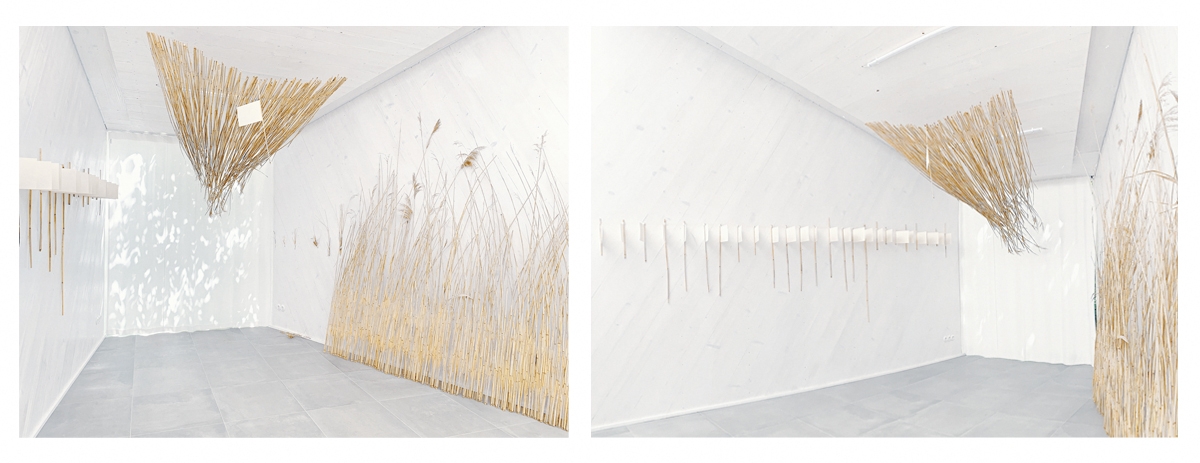Between a Dog and a Wolf , 2022
Straw, paper, photography, text
‘Between a dog and a wolf’ (from the French saying ‘entre chien et loup’) metaphorically means the twilight - a time of day when it is difficult to see things clearly, to distinguish between dogs and wolves, friends or foes. Figuratively, it can mean a time when we do not know whether we are safe or in danger, or whether things are real or unreal.
In this project, I raise questions about current political and ecological thinking, trying to identify parallels between acting and playing on words. I deal with cliches, tropes, and newspeak in times of transformation, in the time between a dog and a wolf. By using straw to create my installations, I am literally and metaphorically grasping at straws - trying to find a way out, to see things more clearly, and to distinguish truth from untruths in the twilight.
I have been examining the issue of borders for a number of years, and in this new project I am shaping a scarecrow from people’s fears in the form of borders - national, social, ethical, and imaginary boundaries and limitations, which divide people from reality and each other.
The straw man fallacy substitutes fake arguments for truth, and marries facts with errors of omission. The farmer’s straw man stands in a field and frightens the birds. Fear stops them from coming closer. The same happens with humans constructing imaginary borders in their minds, dealing with fallacies and not tangible issues. ‘…It means also the ability to believe that black is white, and more, to know that black is white, and to forget that one has ever believed the contrary’ wrote George Orwell in his ‘1984’ novel.
By assembling a simple object from a straw and a piece of blank paper, I am creating several things at once. A blank piece of paper symbolizes what activists worldwide have held up in single pickets, for all kinds of causes. It could also be a flag, or it could be a road sign showing the way to those who are lost. And in all three cases, people may be grasping at straws.
I examine the interconnectedness of the elements and how visualization of human and environmental issues are linked to political and environmental thinking, while exploring the concept of boundaries.
Borders continue to play a central role, multiplying people’s fears and uncertainties. People are becoming more polarized in their thoughts and actions. But the complexity of the current crisis extends beyond the simple dichotomy of walls and borders, and resides somewhere in between.
The Baltic Sea region is situated between several countries. The stability of the global coastline and entire ecosystem depends on cross-border solutions and cooperation. The ultimate reason why ecosystems have lost their balance and we are in crisis is the unprecedented and unsustainable impact of human beings, the way we live, but also the way that people, as a species, regard the natural world.
The current conflicts and crises are affecting humanity, reshaping life in the entire European region and worldwide.
Walls and borders have two sides and involve at least two concepts. They can be helpful as well as harmful. We can use the same materials to divide people or shelter them and give them hope. For example, from straw we can make walls to build borders or fences, or protect people from the sun and stabilise the sand dunes, or build roofs to shelter people. By learning from nature, we can make sustainable tools and, I hope, learn from mistakes we have made in the past, or at least try to mitigate problems caused by previous misguided actions.
Между Cобакой и Волком, 2022
Солома, бумага, фотографии, текст
Фраза «между собакой и волком» (фр. «entre chien et loup», лат. «inter canem et lupum») обозначает сумерки, время недостаточной освещенности – приграничье между светом и тьмой – когда становится сложно разглядеть собака это или волк, друг или враг, правда или ложь.
Проект поднимает вопросы, касающиеся современного экологического и политического мышления, визуализируя параллели между действиями и игрой слов. Хватаясь за соломинку*, художница буквально использует этот материал для своей инсталляции. Определяя восприятие мира как связующее звено между действительностью и мышлением человека, художница создает соломенное чучело*, границу, отделяющую людей от реальности и друг от друга.
Чучело, установленное в поле, пугает птиц и не дает подлететь ближе к цели. Соломенное чучело, объект страхов и манипуляций, ограничивает наши мысли и угол обзора, подменяет истину фальшивыми аргументами, смешивая факты с ошибками и погрешностями в терминологии.
Переносные значения буквально переносят нас в другую реальность. Воображаемые границы и множащиеся страхи достраивают образ, способный направлять и контролировать, способный не видеть аналогий, не замечать логических ошибок, неверно истолковывать даже простейший довод, если он враждебен.
«…Это также означает способность верить, что черное — это белое, и более того, знать, что черное — это белое, и забывать, что кто-то когда-либо верил в обратное», — писал Джордж Оруэлл в своем романе «1984».
Сумеречного освещения недостаточно для нормальной жизнедеятельности человека, но при благоприятных атмосферных условиях четко просматривается линия горизонта.
Психологический эффект видения слов, визуализация проблемы, сталкивает нас с нашим предшествующим знанием и дает возможность увидеть мир в ином свете.
*Держаться за соломинку обозначает попытку найти решение, пробовать необычные или экстремальные идеи или методы, потому что все другие идеи или методы провалились.
*Соломенное чучело (англ. strawman fallacy), один из демагогических приемов, подмена понятий, позволяющее опровергать фиктивную точку зрения с целью обоснования другого утверждения.

